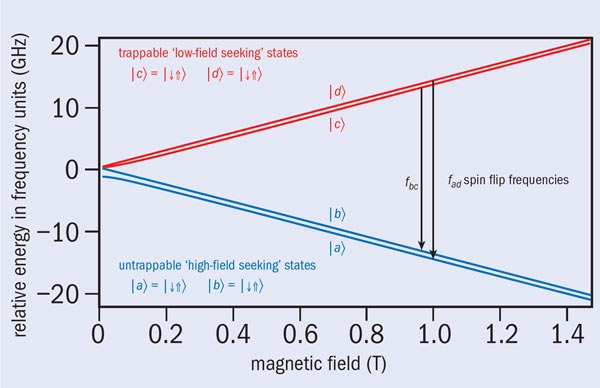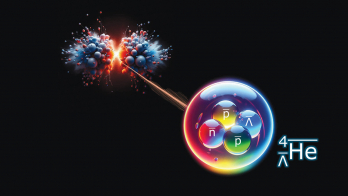
The ALPHA collaboration has reported the first-ever resonant interaction with the antihydrogen atom, observed in their experiment at the Antiproton Decelerator (AD) at CERN.
ALPHA synthesizes antihydrogen from cryogenic plasmas of antiprotons and positrons. While the charged constituents can be easily confined through their interactions with electric and magnetic fields, confining neutral antihydrogen is much more difficult. It can be held in a highly inhomogeneous magnetic field (a “minimum-B” configuration) because it has a magnetic dipole moment, but the interaction is so weak that only atoms with kinetic energy equivalent to 0.5 K or less in temperature can be trapped, using superconducting magnets. This is how ALPHA has already held antihydrogen atoms for up to 1000 s (CERN Courier March 2011 p13 and July/August 2011 p6).
Assuming that antihydrogen behaves like hydrogen, the 1s ground state will exhibit both hyperfine splitting (through the interaction between the spins of the positron and the antiproton) and splitting in a magnetic field (see figure). In a high magnetic field, these states are characterized by the direction of the spins of the antiproton and positron with respect to the field direction. The “low-field-seeking” states labelled |c〉and |d〉 can be trapped, because their energy increases with magnetic field strength. Atoms that end up in the |a〉and |b〉 states (“high-field-seekers”) are expelled from the trap and annihilate in the surrounding apparatus.
In the latest experiment, a horn antenna directed microwaves into the atom trap so as to flip the spin of the positron in the stored atoms, thus driving the transitions |c〉 → |b〉and |d〉→ |a〉. The experimental sequence was as follows: produce and trap antihydrogen (of the order of one trapped atom at a time on average); irradiate the trapped atom with microwaves resonant on either the |c〉 → |b〉or
|d〉→ |a〉transition (these are excited alternately for 15 s each over a total of 180 s); look for evidence of “lost” antihydrogen. To conduct control experiments, it was repeated without microwaves or with microwaves at a shifted off-resonance frequency. Each sequence took about 10 minutes of real time.
The collaboration used two methods to look for evidence of ejected antihydrogen. At the end of each sequence, the atom trap is rapidly de-energized, the fields falling with a time constant of about 9 ms. Any antihydrogen remaining in the trap is released and detected by ALPHA’s three-layer silicon detector over a 30 ms time window. It is then possible to compare the survival rate of anti-atoms for the three cases: no microwaves present, resonant microwaves present, or off-resonant microwaves present. The other detection measurement involves looking for direct annihilations from ejected antihydrogen during the times in which resonant microwaves are present; background (primarily cosmic rays) discrimination here is more challenging because of the longer observation time.
In both types of measurement, ALPHA finds a strong signal for resonant interaction. For example, in 110 trials with off-resonance microwaves, 23 annihilations were observed when the trap was de-energized; with microwaves on resonance, 2 annihilations were observed in 103 trials. (Detection efficiency is about 50% for both cases). The on- and off-resonance measurements localize the resonance to no better than 100 MHz in about 29 GHz; the collaboration has not yet attempted to scan the lineshape to further localize a resonant peak.
This measurement marks the beginning of anti-atom spectroscopy and illustrates that it is possible to make measurements on antimatter atoms using only a few atoms. In 2012 the ALPHA apparatus will give way to ALPHA-2, a new device that is further optimized for precision microwave and laser spectroscopy. ALPHA-2 will be commissioned during the upcoming run of the AD, from May to November.








